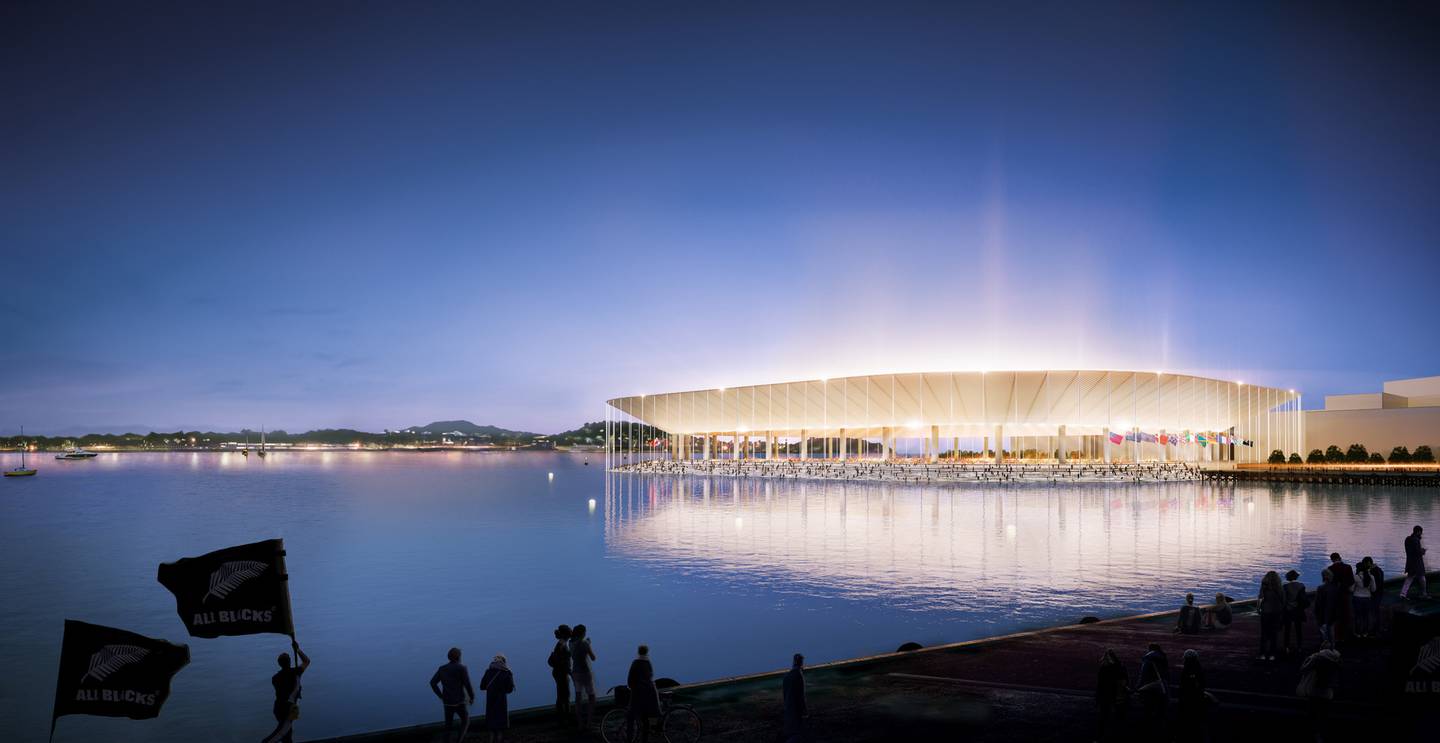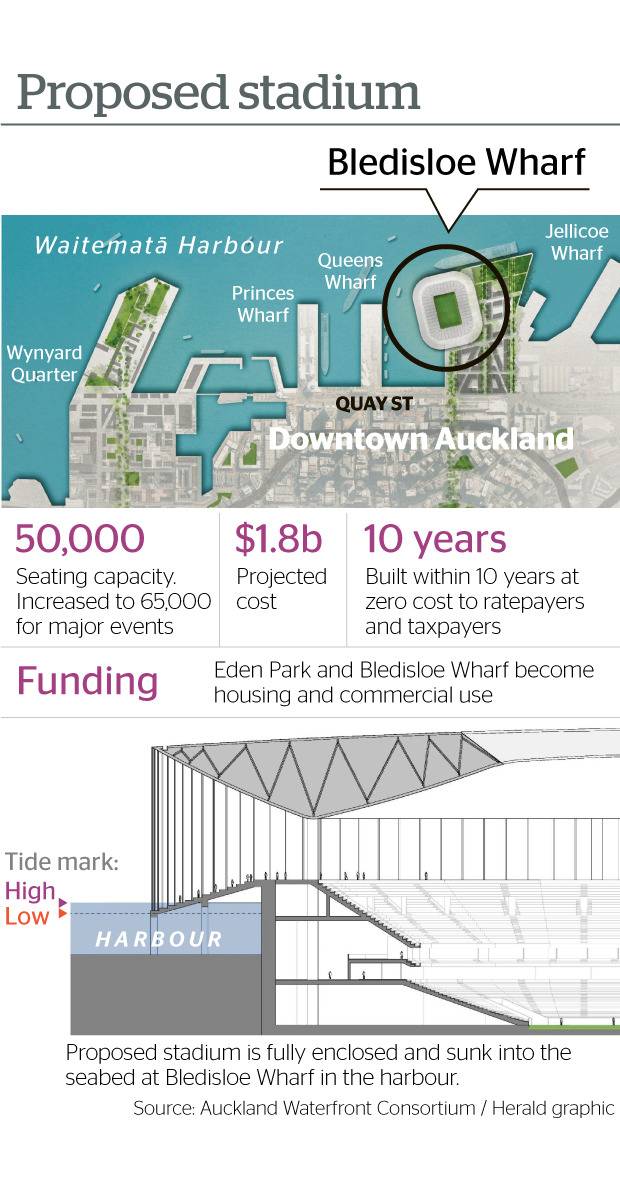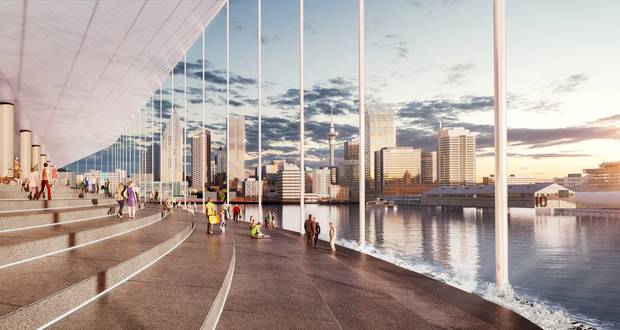Jaw-dropping plans for a new National Stadium sunken into the Auckland waterfront are being unveiled today to gauge public support.
The stadium will cost $1.8 billion and could be built within 10 years at zero cost to ratepayers and taxpayers, says the Auckland Waterfront Consortium.
The "spectacular landmark" is the most serious proposal for a waterfront stadium since the hotly debated proposal for a Government-funded stadium for the 2011 Rugby World Cup was rejected by local politicians in 2006.

Cricket will be played on a new oval tentatively planned by Auckland Council's facilities arm at Western Springs.
The stadium will be built alongside a redeveloped Bledisloe Wharf at Ports of Auckland, partly on reclaimed land and partly sunk into the seabed about 28m below sea level.
Other features are a floating roof above sea level to reduce the loss of harbour views and the removal of Captain Cook Wharf, currently used for car imports.
The consortium said the sunken stadium will be designed and built to accepted seismic principles and modelling to protect against rising sea levels and tsunami.
"Our proposal is exciting, very ambitious, but represents a superb solution for the waterfront and the city as a whole. Importantly it is financially feasible and achievable," says consortium chairman and property valuer Dave Wigmore.
Deputy chairman Michael Sage, a partner at big city law firm Simpson Grierson, said the consortium is going out to the public to gauge support.
"I think the people of Auckland will love it," he said.
To fund the stadium, the consortium wants the rights to build housing on 9ha at Eden Park and develop Bledisloe Wharf along the lines of Wynyard Quarter with apartments, commercial buildings and public space.
This would see the end of Eden Park, a fortress for the All Blacks and home of many of New Zealand's most memorable sporting moments. It would also require the new and used cars business being moved from the port.
The consortium plans to test the feasibility of the project over the next 12 to 18 months.
If it stacks up, it will seek a lead developer who will pay for the land and believes a reconstituted Eden Park Trust Board is the logical party to own and operate the stadium.
Sage said the crucial question for Aucklanders is whether they want the waterfront to be a car park and ugly industrial site or "absolutely world class and something to be proud of".
The Auckland Waterfront Consortium is made up of Wigmore, Sage and 10 professional service companies, which have been working on the project for 18 months.
One of those involved is design and marketing figure Phil O'Reilly, who two years ago pitched a new stadium sunken into the waterfront, dubbed the Crater, which became the idea for the consortium.

Mayor Phil Goff said he was keen to get a sense of what the public think, but made it clear the council has no money in its new 10-year budget for a stadium.
"There are a lot of hurdles." he said.
Goff has been taking a fresh look at a downtown stadium since being elected in 2016 and this year received a feasibility report by PwC costing $923,000 that looked at several sites, costing between $1.1b and $1.5b.
The mayor would not comment about handing over a big chunk of Ports of Auckland land to the consortium, saying it was a matter for the council-owned port company.
The port company, whose chief executive Tony Gibson received a briefing from the consortium on Wednesday, said any decision on port land for a stadium and residential development is a matter for council.

Finance Minister Grant Robertson, who is also Minister of Sport, said officials had met with the consortium and are being kept informed about the proposal.
"The Minister has not met the consortium but is open to doing so at some point," a spokeswoman said.
Eden Park Trust Board chairman Doug McKay said he met Wigmore and Sage at Simpson Grierson's office where they looked out the window and said "that big wharf down there, that's where we are putting the stadium, blah, blah, blah".
McKay said he was not clear what they wanted but wished them all the best, saying his interest is to make sure Eden Park survives and services the needs of Auckland for the next 10 or 20 years.
Michael Stiassny, who chairs Ngati Whatua's commercial arm, Whai Rawa, said the iwi had long supported a new stadium in Auckland, but said it would require significant support from local and central government.
"Our understanding is it (local and central government support) is not available and until it is this is somewhat a wasted discussion," he said.
Stiassny said if ratepayers are going to fund the stadium by giving up publicly-owned port land then there should be a discussion about the best location for a new stadium.
"The work undertaken by PwC for the Auckland Council rated the Ngati Whatua land (on old railway land near Spark Arena) as either the best or one of the best alternatives for a stadium," said Stiassny, who has still to be approached by the consortium.
The National Stadium explained
Seating for 50,000. Able to be upsized to 65,000 for major events
Costed at $1.8 billion
Built within 10 years at zero cost to ratepayers and taxpayers
Funded by turning Eden Park and Bledisloe Wharf into housing/commercial use
Fully enclosed and sunken into Bledisloe Wharf/Waitemata Harbour
Rectangular stadium to be used by rugby, rugby league, cricket, concerts and cultural events
Auckland Waterfront Consortium
Dave Wigmore, property valuer, chairman
Michael Sage, Simpson Grierson lawyer, deputy chairman
Members
Engeo Ltd, engineering
Jones Lang Lasalle, commercial real estate
EY, international professional services
Simpson Grierson, legal
Peddle Thorp, architects
Planning Focus, resource management
Phil O'Reilly Design, design
Rider Levett Bucknall, quantity surveyors
The Property Strategists, Wigmore's property business
Buildmedia, imagery and animations












